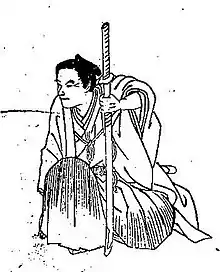Takayama Hikokurō
Takayama Hikokurō (高山 彦九郎) (15 June 1747 – 4 August 1793) was a Japanese samurai and historian, and one of the early proponents of the sonnō jōi movement which became highly influential during the Bakumatsu period in the events leading to them Meiji restoration. He was later known as one of "Three Excelling Men of the Kansei Period" (Kansei no san-kijin 寛政の三奇人).[1][2] His Dharma name was Shōin Ihaku Koji (松陰以白居士).[3]

Biography
Takayama was the son son of Takayama Ryōzaemon Masakiyo, a local samurai in what is now part of the city of Ōta, Gunma. He claimed descent from Takayama Shigehide, one of the 16 companions of Nitta Yoshisada, the famed imperial loyalist during the wars of the Nanboku-chō period. After reading the medieval chronicle Taiheiki at the age of 16 he became a Buddhist priest and at the age of 18 left home (leaving behind a suicide note) and travelled around the country spreading his theories on the supremacy of the Imperial house and illegitimacy of the Tokugawa shogunate. During his travels, he cultivated a wide circle of acquaintances with whom he regularly corresponded, including Hayashi Shihei, Uesugi Harunori, Hirose Tansō and others. Thwarted in his efforts to reach Ezo due to high security by the shogunate, he turned to Kyoto instead. He resided for a time at the house of the kuge Iwakura Tomokazu, presented a memorial to Emperor Kōkaku and wrote numerous patriotic poems. He was outranged by the treatment of Dainagon Nakayama Naruchika by the shogunate over an issue pertaining to the regnal name for Emperor Kōkaku and publicly criticized the rōjū Matsudaira Sadanobu. Forced to leave Kyoto, he travelled to Kyushu in hopes of enlisting Satsuma Domain in his efforts against the shogunate, but was rebuffed. After traveling to various parts of Kyushu, he was arrested by the shogunate at the home of a friend in Kurume, Fukuoka and was invited to commit seppuku.
Takayama left a dairy which later influenced Yoshida Shōin and the proponents of the Meiji restoration, and following the establishment of the Meiji government, he was upheld, along with Kusunoki Masashige and Ninomiya Sontoku as examples of imperial loyalists in pre-war patriotic education.
He is best known, however, for a large bronze statue in front of Sanjō Ōhashi in Kyoto, depicting Takayama bowing in the direction of the Kyoto Imperial Palace. The statue was erected in 1924 to celebrate the accession of Emperor Hirohito. It was melted down in 1944 for metal for use in the war effort, and replaced with a stone stele with writing by Tokutomi Sohō. The statue was finally restored in 1961.
Takayama Hikokurō former residence and hair mound
The location of the house where Takayama was born in Ōta, Gunma was proclaimed a National Historic Site in 1931,[4] together with a mound in the nearby family cemetery containing his severed topknot of hair, which was brought back to his family after his suicide. The house has long been demolished and the site has reverted to farmland, but some traces of the well and hedges remain. The location is about a 10-minute walk from Hosoya Station on the Tōbu Railway Isesaki Line. The Takayama Hikokurō Memorial Museum is located a short distance away.[5]
References
- Murata, Tadayoshi (17 June 2016). The Origins of JapaneseChinese Territorial Dispute: Using Historical Records to Study the Diaoyu/Senkaku Islands Issue. World Scientific. p. 82. ISBN 978-981-4749-12-1.
- Vaporis, Constantine Nomikos (23 March 2020). Breaking Barriers: Travel and the State in Early Modern Japan. Brill. p. 151. ISBN 978-1-68417-303-7.
- "吉田寅次郎が名乗った「松陰」と「二十一回猛士」の由来". 吉田松陰.com (in Japanese). Retrieved 14 October 2019.
- "高山彦九郎宅跡 附 遺髪塚". Cultural Heritage Online (in Japanese). Agency for Cultural Affairs (Japan). Retrieved 11 August 2020.
- Ōta city official home page